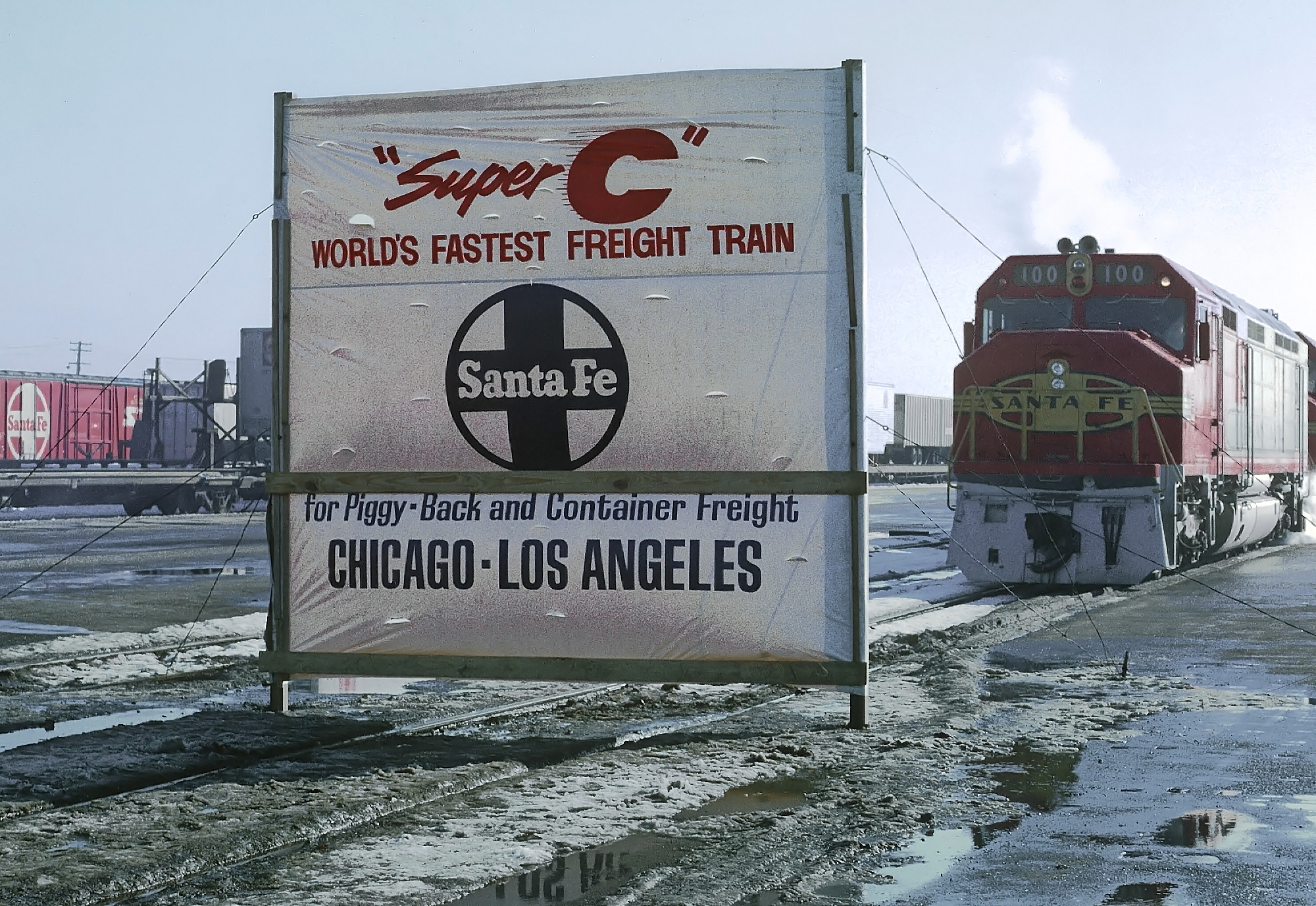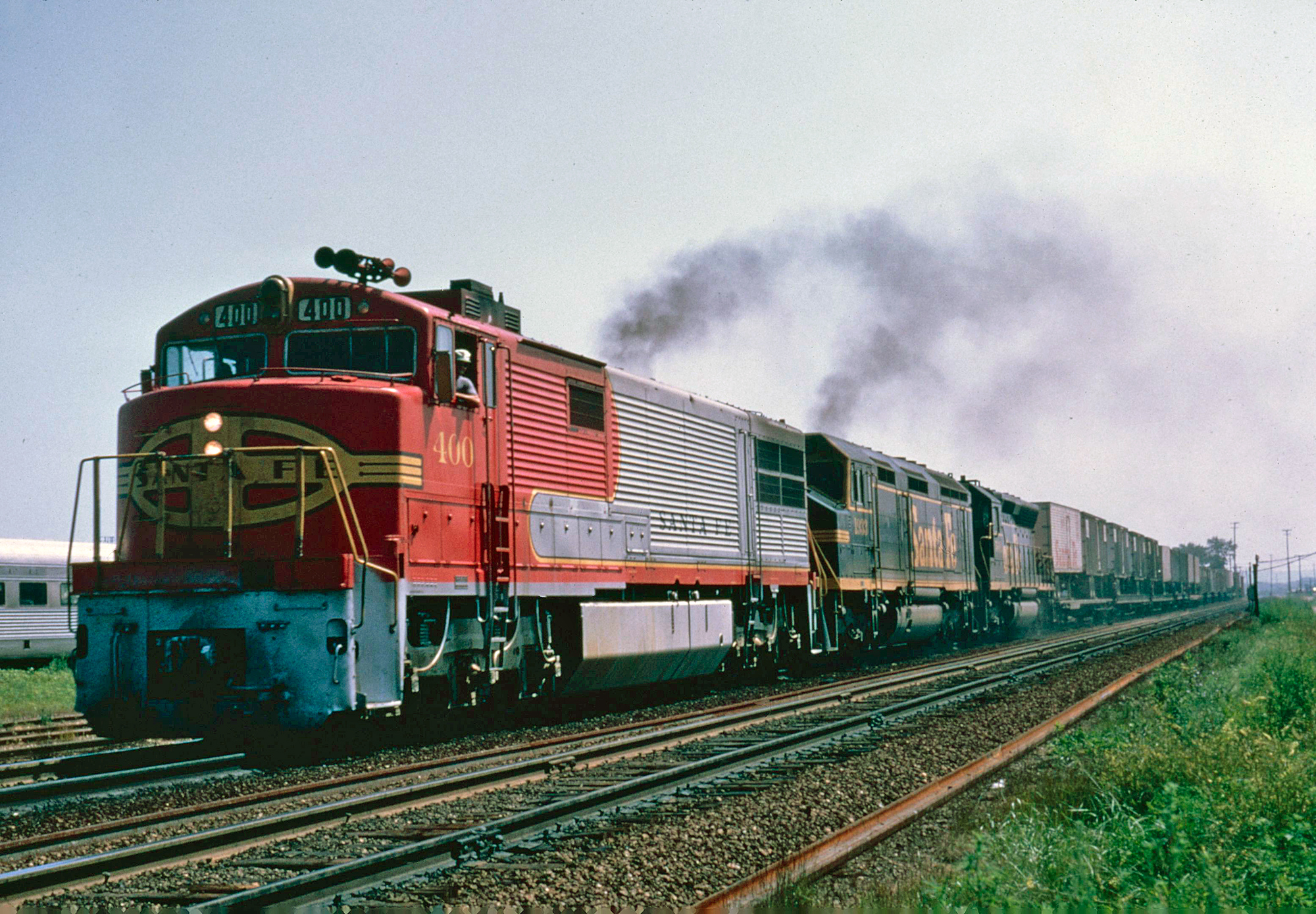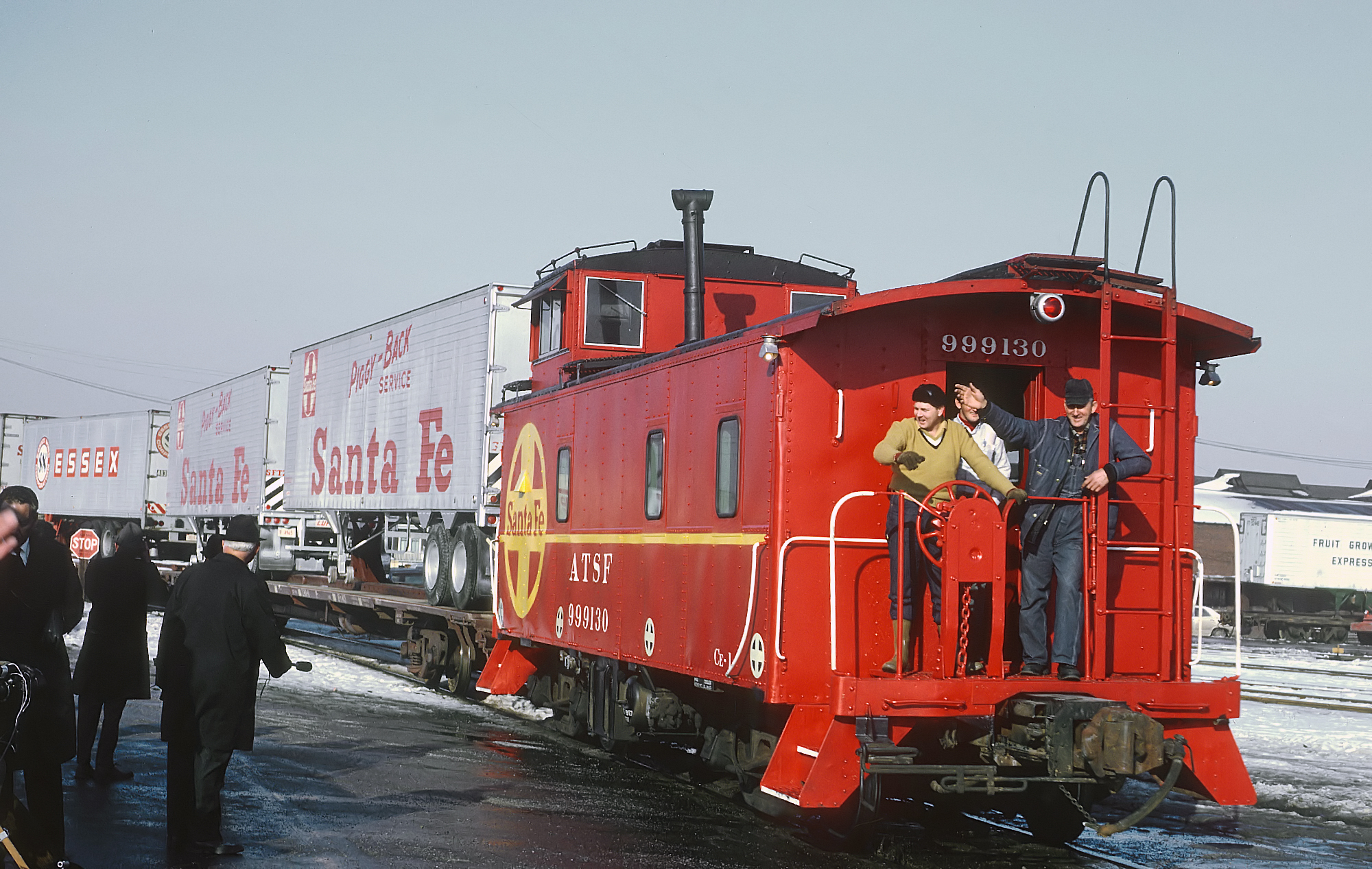The "Super C" (Train): Top Speed, Schedule, History
Last revised: February 25, 2025
By: Adam Burns
The Super C was a high-speed freight train operated by the Atchison, Topeka and Santa Fe Railway.
It was introduced in 1968 and was known for its fast service between Chicago, Illinois, and Los Angeles, California, covering the distance in less than 40 hours. Several factos led to the Super C's 1976 discontinuance which included:
- Too few customers
- High operational costs
- Competition from the trucking industry
- Union Pacific and Chicago & North Western launching a competing, 50-hour high-speed freight service in 1976 which grabbed the Super C's mail contract.
Photos
 The Santa Fe went to great lengths publicizing its new "Super C" high speed freight service. Seen here is a sign showcasing the train at Corwith Yard in Chicago on January 17, 1968. In the background can be seen the FP45s leading the train. Roger Puta photo.
The Santa Fe went to great lengths publicizing its new "Super C" high speed freight service. Seen here is a sign showcasing the train at Corwith Yard in Chicago on January 17, 1968. In the background can be seen the FP45s leading the train. Roger Puta photo.Inauguration
The Super C, an iconic symbol of the Santa Fe Railway, stretched across the Southwest United States between Chicago and Los Angeles. Enshrined into service on January 17, 1968, the Super C significantly transformed the transportation landscape of the United States.
This groundbreaking train - boasted by the AT&SF as the "World's Fastest Freight Train," passed through the sprawling landscapes of Arizona, New Mexico, and Texas, initially running a schedule of 37 ½ hours, averaging 58.2 miles per hour on its first run. Its second run shaved three hours from the schedule improving to 34 ½ hours and averaging 63.7 mph.
Purpose
The Super C was introduced with the primary goal of delivering cargo at unmatched speeds. Its purpose was to champion high-speed freight service, disrupting traditionally slower services and offering speedy delivery of time-sensitive goods.
The train typically pulled either TOFC (Trailer-On-Flatcar) or COFC (Conatiner-On-Flatcar) equipment with a total of 15-20 cars per consist. Fast freights of that era were not a new concept although are practically unheard of today as trucks have captured nearly 100% of this time-sensitive business (such as perishable foods).
The Super C specialized in carrying hot freight, a term used to describe high-priority, time-sensitive items. Hot freight typically included goods like auto parts, electronics, and United States Post Office mail. This train was, quite literally, the vehicle for the fast-paced American economy of the time.
Top Speed
The Super C touted impressive top and average speeds during its operation. Its highest recorded speed peaked at 79 mph, while it maintained an average speed of 63.7 mph for the majority of its trips. This was notably higher than the average speeds of other freight trains operating during the same period.
This fast pace resulted in significantly reduced trip times. A standard journey from Barstow to Chicago typically required less than 40 hours—a stark contrast to the 55-75 hours it would take traditional freight trains.
The remarkable performance of the Super C was powered by diesels geared for high speed operation. The train's initial run was led by FP45s while later U30CGs, U28CGs, SD45s, SD45-2s, and even F3s could all be found at the head-end.
 Santa Fe U30CG #400 leads the expedited "Super C" westbound through Chillicothe, Illinois during the 1960s. Photographer unknown. American-Rails.com collection.
Santa Fe U30CG #400 leads the expedited "Super C" westbound through Chillicothe, Illinois during the 1960s. Photographer unknown. American-Rails.com collection.Decline
Despite its superior performance, the Super C eventually succumbed to the pressures of declining profits. The rise of air travel as a convenient means of transporting people and small, high-value items coupled with a decrease in mail contracts spelled the beginning of the end for the service.
Ultimately, the Super C made its final run on May 20, 1976, a date marked by both a sense of nostalgia and recognition of the end of an era. The legendary train, known for its speed, reliability, and utility, remains an important memory in the annals of American rail history.
Legacy
Without a doubt, the Super C was more than just a train. It encapsulated the spirit of innovation, the determination to navigate challenges, and the relentless pursuit of progress. Today, as Santa Fe continues to inspire wonder, the legacy of the Super C stands as a testament to the awe-inspiring power of the rails.
Looking back at its operation, it’s clear the train's revolutionary nature came at a time when both industry and consumers craved faster, more efficient logistics solutions. The Super C directly responded to these demands, heralding a new era in freight transportation.
Its legacy continues to shape contemporary freight services, inspiring rail companies worldwide to prioritize speed and efficiency. And while the Super C may be a figure of the past, its impact on the landscape of freight transportation has been nothing short of timeless.
The train served as a visionary model of what a freight service could be, particularly in an era of growing impatience and changing consumer demands. It combined technological innovation with strategic planning to create a service that had never been seen before.
The Super C’s exceptional speed and dependability facilitated the success of countless businesses, both large and small. It provided a secure and reliable means of transportation for many commercial entities, thereby driving economic growth and fostering the seamless movement of goods across the United States.
While the train's journey was certainly marked by impressive feats, it also encountered formidable challenges. It grappled with fluctuating demand, operational hiccups, and the inevitable march of technological progress, all of which led to its eventual discontinuation.
Although the Super C’s operation eventually came to a halt, its spirit of innovation continues to live on. It remains a powerful symbol of the capabilities and potential of rail freight transportation, inspiring future generations to continually push for progress and innovation.
Even in its absence, the Super C’s legendary reputation continues to reverberate within the rail industry. Its lasting legacy has cemented the Santa Fe Railway’s reputation as a leader in freight innovation, pioneering the realm of high-speed freight service.
 Santa Fe caboose #999130 brings up the tail end of the "Super C" on its inaugural run as it departs Chicago's Corwith Yard on January 17, 1968. Roger Puta photo.
Santa Fe caboose #999130 brings up the tail end of the "Super C" on its inaugural run as it departs Chicago's Corwith Yard on January 17, 1968. Roger Puta photo.Despite the challenges and eventual decline of the Super C, its history serves as a testament to the capabilities of rail logistics. It underscores the tremendous potential freight trains possess in providing efficient, reliable, and sustainable modes of transport.
The train's story, while marked by both triumph and failure, provides valuable lessons about the ever-evolving nature of the transport industry. It reminds us of the importance of adaptability and foresight in an industry often dictated by technological advancements and changing demands.
In retrospect, the Super C was much more than just a train. It was an embodiment of progress and ambition—an audacious dream converted into a tangible reality that forever changed the course of freight transportation. Its legacy, while embodied in steel and diesel, continues to leave an indelible mark on the canvas of American rail history.
Sources
- Bryant, Jr. Keith L. History Of The Atchison, Topeka & Santa Fe Railway. New York: Macmillan Publishing Company, 1974.
- Glischinski, Steve. Santa Fe Railway. St. Paul: Voyageur Press, 2008.
- Schafer, Mike. Classic American Railroads. Osceola: MBI Publishing, 1996.
Recent Articles
-
Rio Grande 2-8-2 Locomotives (K-37): Specs, Roster, Photos
Apr 15, 25 12:57 PM
Rio Grande's Class K-37 Mikes were itsdge steamers to enter service in the late 1920s. Today, all but two survive. -
Rio Grande 2-8-2 Locomotives (K-36): Specs, Roster, Photos
Apr 15, 25 11:09 AM
The Rio Grande's K-36 2-8-2s were its last new Mikados purchased for narrow-gauge use. Today, all but one survives. -
Rio Grande 2-8-2 Locomotives (Class K-28): Specs, Roster, Photos
Apr 14, 25 10:24 PM
Rio Grande's Class K-28 Mikados were its newest narrow-gauge steam locomotives since the Mudhens of the early 1900s. Today, three survive.


